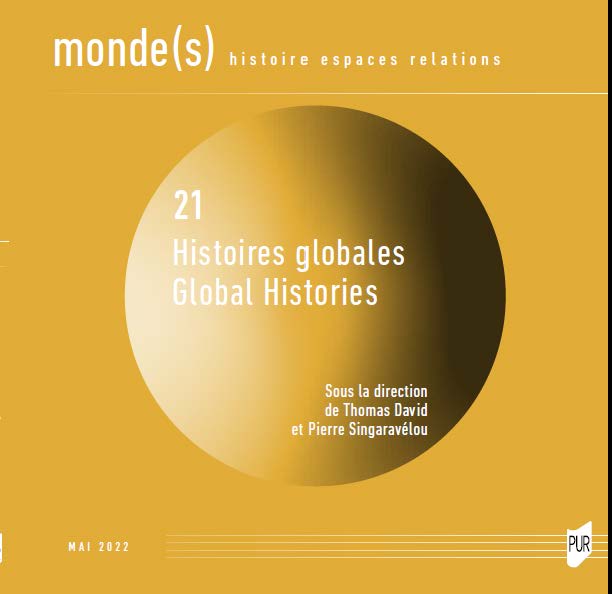Archives / 21 Histoires globales- Global Histories
Revue Monde(s). Histoire, espaces, relations
n°21 – 2022/1 – sortie mai 2022
Histoires globales/Global Histories
Conversations transnationales/Transnational Conversations
sous la direction de Thomas David
et Pierre Singaravélou
Sommaire
Histoires globales : conversations transnationales
Global Histories : Transnational Conversations
Sous la direction de Thomas David et Pierre Singaravélou
Avant-Propos
Robert Frank, Stanislas Jeannesson
Dossier : Histoires globales : conversations mondiales
Global Histories : Transnational Conversations
L’histoire globale est-elle globale ?
Thomas David, Pierre Singaravélou
From the Globe to the Planet ? New Challenges of Global and Environmental History
Antoine Acker, Laurent Warlouzet (coord.)
Conversation with Debjani Bhattacharyya, Roberta Biasillo, Iris Borowy, Claudia Leal, Christof Mauch and Grégory Quenet
Le monde a-t-il un genre ?
Sabine Dullin, Fabrice Virgili (coord.)
Conversation avec Oluwakemi Abiodun Adesina, Benjamin A. Cowan, Yulia Gradskova, Svetlana Shakirova,Anna Sidorevich et Christina Wu
Connected Ogres : Global Sources in the Digital Era
Dzovinar Kévonian, Philippe Rygiel (coord.)
Conversation with Simon Burrows, Jennifer Edmond and Jo Guldi
Focus : Global History in the Digital Age since Histoire de l’Afrique
Jean-Pierre Bat
Beyond « Plato to NATO ». Navigating the Global Turn in the History of Science, Technology, and Medicine
Jérôme Baudry, Yi-Tang Lin (coord.)
Conversation with Lisa Hellman, Kenji Ito, Matheus Alves Duarte da Silva and Helen Tilley
Histoire(s) globale(s) : convergences et inégalités
Thomas David, Anne-Isabelle Richard, Pierre Singaravélou (coord.)
Conversation avec Sven Beckert, Elisabeth Dikizeko, Ali Raza et Barbara Silva
Focus : Les archives coloniales néerlandaises dans l’établissement d’histoires globales et locales
Jos Gommans
Varia
La lutte armée au Congo et au Cameroun. Un acteur inattendu : le Parti communiste italien
Gabriele Siracusano
Résumé
Cette étude vise à analyser les rapports entretenus par l’UPC (Union des populations du Cameroun) et le MNC (Mouvement national congolais) avec l’un des plus importants partis communistes d’Europe occidentale : le Parti communiste Italien (PCI). L’histoire de ces partis est lue à travers un regard à la fois « européen » et « global », connecté aux évènements internationaux et aux changements intervenus à l’intérieur du mouvement communiste. Les communistes italiens, qui refusent la violence révolutionnaire en faveur d’une « voie démocratique » vers le socialisme, entretiennent des contacts avec deux organisations qui ont choisi la lutte armée, l’UPC et le MNC. Dans ces deux mouvements coexistent des idéologies différentes. Les Camerounais ont une aile « modérée », moins inspirée des principes du marxisme-léninisme, et une aile « dure », proche du Parti communiste français, mais aussi de l’idéologie maoïste. Les militants du MNC, rassemblés autour de Antoine Gizenga, ont des contacts importants avec l’URSS mais ils font aussi référence au modèle chinois. L’intérêt des Italiens pour les voies socialistes nationales et pour un « polycentrisme » dans le mouvement communiste rapproche le PCI des mouvements anticoloniaux africains, mais les évènements internationaux modifient bientôt ces rapports de solidarité et collaboration.
Mots-clefs : Parti communiste italien – Union des populations du Cameroun – Mouvement national congolais – Cameroun – Congo.
Abstract
Armed Struggle in Congo and Cameroon. An Unexpected Actor : The Italian Communist Party
This study examines the relationship between, on the one side, the UPC (Union des populations du Cameroun) and the MNC (Mouvement national congolais) and, on the other, one of the most important communist parties in Western Europe: the Italian Communist Party (PCI). These organizations are studied through a European and a global lens, and in connection with international events and changes within the communist movement. The Italian communists, who rejected revolutionary violence in favor of a democratic path towards socialism, maintained contacts with two organizations that chose armed struggle : the UPC and the MNC. Different ideologies coexisted in these two movements. The Cameroonians had both a “moderate” wing, which was less inspired by the principles of Marxism-Leninism, and a “hard” wing, which was close to the French Communist Party as well as to Maoist ideology. The militants of the MNC, unified around Antoine Gizenga, had important contact with the USSR, but also used the Chinese model as a reference. The interest of Italian communists for national paths and for “polycentrism” in the communist movement drew the PCI closer to African anti-colonial movements; however, international events soon modified these relationships of solidarity and collaboration.
Keywords: Italian Communist Party – Union des populations du Cameroun – Mouvement national congolais – Cameroon – Congo.
